
Two days before Christmas 1914, on a windy and bitterly cold Chicago day, a small, scruffy man with tousled black hair descended from a train just arrived from California. He wore no overcoat, and his luggage totaled only a small bundle of clothes. No one in the station's bustling crowd gave any indication that they recognized the man-assuming they took any notice at all of the diminutive tramp.
His companion, on the other hand-a well-built man with heroic features, named Gilbert M. Anderson-may have elicited some gasps of recognition. In scores of short silent film Westerns, Broncho Billy, as Anderson was known, had become the movies' first cowboy star. Seven years earlier, in 1907, he had paired up with a budding film producer named George K. Spoor to form a Chicago-based movie studio called Essanay, a name derived from the initials of the men's surnames ("S and A"). Now Anderson, who shot most of his movies in Colorado and California, had come home to Chicago, bringing along Essanay's newly signed star, a brash cockney comic named Charles Spencer Chaplin.
The British-born Chaplin had first visited Chicago in 1910, while touring the American West with a vaudeville troupe. Then (as Chaplin would write in his 1964 autobiography), he had found Chicago "attractive in its ugliness, grim and begrimed. . . . It had a fierce pioneer gaiety that enlivened the senses, yet underlying it throbbed masculine loneliness"-a loneliness Chaplin assuaged with visits to the local burlesque halls and a libidinous longing for the showgirls who roomed at his small Wabash Avenue hotel.
When he arrived in the Windy City in 1914, Chaplin stayed with Anderson and his wife, Mollie, at the couple's apartment at 1027 West Lawrence Avenue, just a few blocks from the Essanay studios. The product of a broken home-his parents, London music-hall entertainers, had separated when he was a baby-Chaplin delighted in the Andersons' holiday domesticity, and in their little daughter, Maxine. "A Christmas tree, a baby, a Christmas tree," he exclaimed. "It's wonderful!"
On New Year's Eve, the Andersons took Chaplin to the Hotel Sherman (at Clark and Randolph streets), home to the fashionable College Inn restaurant and its burgeoning jazz scene. Appalled, Mollie realized that Chaplin had his pajama bottoms wrapped around his neck, and she managed to find him a scarf. At the restaurant, an enthusiastic vaudeville performer picked out Chaplin and made him stand on his chair. "Ladies and gentlemen," the vaudevillian cried out to the festive crowd. "I want to introduce you to the funniest man in moving pictures-Charlie Chaplin."
On Argyle Street just west of Broadway, two red brick buildings stand as a monument to the early days of film, when Chicago reigned as the country's movie capital. Home today to St. Augustine College, the buildings (at 1343-45 West Argyle), seen from the street, look a little rundown, though their rear façades, augmented by new entryways topped in faux red tiles, have a California mission feel. But it's the main entrance to the western building (at 1345) that catches the eye. Tall letters spell out essanay, and the doorway is flanked by the terra cotta heads of two Indians in colorful feathered headdresses, the studio's trademark.
|
One of the studio's former sound stages, housed in the building on the east (at 1343), is known today as the college's Charlie Chaplin auditorium-though there's hardly a chair in sight. The big, high-ceilinged room is virtually empty, its walls unadorned but for a poster for The Kid, a film Chaplin made in 1921, five years after he had left Essanay. Catwalks crisscross overhead. In My Autobiography, Chaplin insisted that, along with his tramp persona, he needed only a pretty girl and a policeman to produce a movie comedy. Add a couple of klieg lights to those modest ingredients, and filmmaking might easily resume at any moment inside this Uptown auditorium.
But sadly, a century after Essanay made its first movie-a simplistic one-reel comedy filmed in 1907-the lights have gone out on Argyle Street. Over ten quick years, though, Essanay (here and at its sister studio in California) made some 2,000 movies. Along with Chaplin, stars such as Gloria Swanson, Wallace Beery, and Francis X. Bushman frequented the Argyle Street studio-that is, when they weren't shooting scenes in the streets around the city. They enjoyed romance, sparked scandal, and, in general, previewed the Hollywood lifestyle of the future. Ultimately, though, the business packed up and moved west, driven away in part by the brutal Midwestern winters.
Chicago's central role in the movies' nascent history had probably commenced around 1895, when George Spoor-a Chicago newspaper vendor and the box-office manager at the Waukegan Opera House-partnered with the mechanically-inclined Edward Amet to develop the Magniscope, an early movie projector.
Waukegan audiences thronged the opera house to view those first magic-picture shows, but Amet thought the novelty was only a passing fad, and he sold his rights to the invention to Spoor.
A 20-something Highland Park native (he was born there in 1871) with the calm reserve of an expert poker player, Spoor established a company to distribute projectors and movies nationwide. (In 1907, two of Spoor's employees, Donald Bell and Albert Howell, would start their own movie-projector company, Bell & Howell.) The public clamored for more flicks, and Spoor realized there was plenty of money to be made. All he needed was a partner with some moviemaking savvy. Broncho Billy to the rescue!
Born Max Aronson in Little Rock, Arkansas, in 1880, Gilbert Anderson had begun his movie career in 1903, the year he appeared in The Great Train Robbery, the first movie with a plot. He had made a few films at Selig Polyscope, a Chicago studio led by the self-styled "Colonel" William Selig, but now he longed for more autonomy. He and Spoor joined forces to create the Peerless Film Manufacturing Company, which they renamed Essanay in August 1907. The studio was "probably the MGM of the silents," says William Grisham, the Evanston movie historian who in the 1960s interviewed Mollie Anderson and some of the Essanay principals. (Academy Chicago Publishers expects to publish Grisham's book about the local movie scene later this year.)
What's more, the Essanay movies-and those made by Selig and others-established film as a dramatic and entertaining new art form. "They built the foundation for an industry that didn't exist before and changed the world," says David Kiehn, the historian for the Niles Essanay Silent Film Museum (in Fremont, California) and the author of Broncho Billy and the Essanay Film Company. "Unfortunately, 1907 to 1918, when they were all thriving, is a black hole in film history."
Fortunately, some of Essanay's movies have survived, including its first picture, a quickie comedy featuring a mustachioed, cross-eyed man named Ben Turpin, who would also emerge as one of the medium's first stars.
* * *
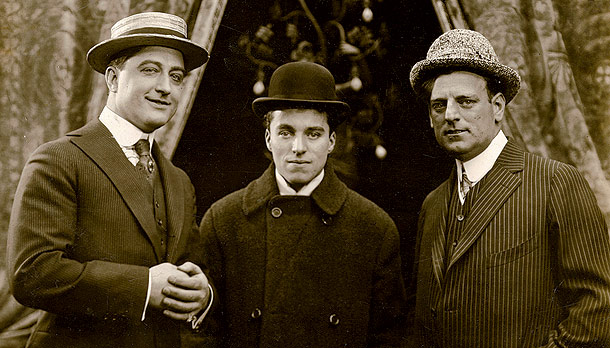
Photograph: Chicago History Museum

Three Essanay stars (from left): Francis X. Bushman, Chaplin, and Broncho Billy Anderson
Born in New Orleans in 1869, Turpin had already had a varied career in show biz by the time he arrived at Essanay, having performed in circuses, burlesque, and vaudeville. At Essanay, he worked as a janitor and shipping clerk, a property boy and scenery shifter, a "telephone girl" and scenario writer. Before moving to Argyle Street, the studio had its offices at 501 North Wells Street, which was also home to the Richardson Roller Skate Company. So it only made sense that Essanay's first film, An Awful Skate, or The Hobo on Rollers, featured an inept skater-Turpin-careening down Wells Street. "Whatever pedestrians were on the streets got in the picture, too, and saved us [from hiring] that many extras," Spoor recalled in 1929.
Turpin's physical antics characterized the studio's early style, described as "rapid fire comedy" in an early review. "This is a great life," said Turpin in 1909. "I had many a good fall, and many a good bump, and I think I have broken about twenty barrels of dishes, upset stoves, and also broken up many sets of beautiful furniture, had my eyes blackened, both ankles sprained and many bruises, and I am still on the go."
In early 1908, Anderson directed a more ambitious dramatic film, The James Boys in Missouri, the first movie ever made about Jesse James and his gang. In this instance, he used Chicago's Riverview Park and Scottdale (in southwestern Michigan) as settings for his story. Frustrated with the Midwestern winters, Anderson made most of his films after 1909 in the West, first in Colorado and eventually in Niles, California, where Essanay built a second studio.
Even as Essanay began to establish itself as a major producer, it ran into a potential legal problem. Thomas Edison claimed industry professionals were infringing on his patents. To resolve the competing claims, Essanay and other studios formed a trust with Edison and all other patent holders in 1908-the same year Essanay began building its new studio on Argyle-called the Motion Picture Patents Company. The arrangement locked out any other "independent" studios, and the trust was accused of using "goon tactics" to foil any competitors-a charge that would come back to haunt Essanay and contribute to its downfall.
* * *
Essanay landed one of its biggest stars in 1911, when Francis X. Bushman joined the studio. "I put all of my emotions in my jaw," claimed the brawny Baltimore native, who as a young man had posed for a number of prominent statues-such as the Francis Scott Key Memorial in his hometown. "His classic profile and wavy locks literally drove the girls into a frenzy," said Louella Parsons, who, before gaining renown as a Hollywood gossip columnist, read scripts for Essanay. ("Manuscripts came in on pencil tablets, torn envelopes, and even on bits of wallpaper," she later recalled.)
|
In 1912, Essanay started pairing Bushman with Beverly Bayne, a beautiful young brunette from Hyde Park. When she was 16, Bayne had walked into the studio wearing a tan suit and a hat festooned with pink roses. Impressed by her big brown eyes and soft dark hair, the Essanay switchboard operator summoned a director. He had Bayne come back a week later, when he gave her a script to read. Perusing it over a bowl of soup in a nearby restaurant, she was astonished to realize she had been given the starring role.
It wasn't long before Bayne was playing opposite Bushman in a series of love stories. "It's romance, just romance," Bushman told Photoplay, one of the first movie fan magazines. "We all know the ordinary ways of ordinary lives. We know that the peddler on Halsted Street and the bricklayer and the teamster have loves, and hates, and hopes, and disappointments. . . . It's not the world we know, but the world we'd like to know that we wish to see set in mimic. If it makes us forget for a little time our cares and worries, it is good."
In her later years, Bayne described her early films as "awful" and recalled the seemingly random way they were produced. "Most of the time there wasn't even a script to work on," she told the author Richard Maturi. "The director and a sort of ‘idea man' just worked it out as we went along. . . . In the silent movies we didn't learn lines. We learned a story's continuity and how to put ideas across with expressions and gestures."
Bushman recalled those days more fondly. "In the old days we acted with a capital A," he said. "We had to let people all over the world know what we meant when we shook a fist or smiled or breathed deeply. The pantomime we used was the Esperanto of the times."
In 1914, the readers of Ladies' World magazine picked Bushman as their favorite leading man. Crowds followed him everywhere, and the star lived up to their expectations. He drove a custom 20-foot-long Marmon auto, with his name spelled out in gold letters. At night, a spotlight inside the car illuminated his famous profile.
What Bushman's adoring public didn't know was that he had a wife and five children in Baltimore. "If he had been afflicted with five serpents it would not have been more of a handicap in a publicity way," wrote Parsons in her 1944 memoir, The Gay Illiterate. "Spoor nearly went out of his mind keeping the fact from the palpitating fans that his Adonis had ‘begat' five offspring, and it was a hush-hush job that required a bit of doing." One woman even showed up at the studio in a bridal gown, determined to marry the star.
In May 1915, Bushman left Essanay for a more lucrative contract at Metro Pictures, taking Bayne with him. Bushman's wholesome image took a hit, however, when the public learned of his secret life. In 1918, he divorced his wife and married Bayne three days later. His popularity waned, and Metro let his contract expire at the end of the year. In 1925, Bayne divorced Bushman, just as he was making a comeback as the chariot-riding villain Messala in Ben-Hur. But Bushman's career still failed to take off (there were rumors of a blacklisting by the movie mogul Louis B. Mayer), and he resorted to working on radio soap operas and on television. He died in 1966 shortly after appearing as a wealthy collector of silent films on the campy TV show Batman.
* * *

Photograph: Chicago History Museum

While Essanay's George Spoor huddles inside his overcoat (hatless, at right), Gloria Swanson smiles warmly from behind the camera.
Born in Chicago in 1899, Gloria Swanson first visited Essanay's Argyle Street studio when she was 15. Parsons would remember her as "a scrawny little thing with enormous ice-water blue eyes and a head that seemed too big for her petite body." Swanson had serious dramatic aspirations and so was dismayed when she witnessed a pile of men and women, some of them wearing roller skates, screaming and thrashing about in a hot, smelly basement. "I certainly didn't think it was funny," Swanson wrote in her 1980 autobiography, "especially when the skaters scrambled to their feet and dusted off their clothes and we could see that they had all been sitting on a great big woman who was lying in the middle of the floor." The "woman" was the lumbering Wallace Beery, a former elephant trainer for the Ringling Brothers circus. He had gone on to become a Broadway star, and now, clad in a wig and gingham dress, he had attained movie stardom as a klutzy Swedish maid named Sweedie.
On the day of her visit, a casting director noticed Swanson and immediately hired the ingénue; she soon appeared opposite Beery in Sweedie Goes to College. When a scandal involving an underage girl forced Beery to leave Chicago for California, Swanson later followed, and in 1916, just after her 17th birthday, they were married. Their romance, however, didn't survive their wedding night, when Beery forced himself on his virgin bride. In her memoir, Swanson describes the scene as a brutal rape, and the couple divorced in 1919.
Beery went on to win a best-actor Oscar for 1931's The Champ, opposite the child star Jackie Cooper. Swanson is likely best remembered today for her 1950 comeback as the delusional former silent-film star Norma Desmond in Billy Wilder's Sunset Boulevard. But in 1915, all that lay far in Swanson's future. First she would have to deal with Charlie Chaplin.
* * *
|
>> SEEING ESSANAY
The movie historian David Kiehn estimates that Essanay-which at its peak cranked out about six movies a week-shot some 1,500 films in Chicago and another 500 out west. Many of them burned in a studio vault fire in 1916, and others ended up in the trash when George Spoor, one of the studio's founders, sold the company's Argyle Street building around 1932. Today, only about 200 Essanay movies survive-stored at the Library of Congress and other archives-but most of them are not readily available for home viewing. All of Charlie Chaplin's Essanay comedies, beautifully restored, are available on three DVDs from Image Entertainment. Rent them at Facets Multimedia (1517 W. Fullerton Ave.; 773-281- 9075 or facets.org), or order them at amazon.com ($22.99 each). This summer in Fremont, California, the Niles Essanay Silent Film Museum will screen 55 Essanay movies-some not seen in 90 years-at its tenth annual Broncho Billy Silent Film Festival (June 29th to July 1st; nilesfilmmuseum.org). Paul Peditto's play Sounds of Silents, a somewhat different take on Chaplin and Essanay (recently staged here by Prop Theatre), is available from Dramatic Publishing ($6.50; dramaticpublishing.com). |
Having arrived in Chicago in December 1914, Chaplin made it his first order of business to find the baggy pants, oversize shoes, and other garb he needed to transform himself into the Little Tramp, the character he had created for Kid Auto Races at Venice, his second comedy for Mack Sennett's Keystone Studios. Shopping on State Street, Chaplin bought some trousers, but it took a long search to find boots big enough for the desired comic effect.
Chaplin's first day at Essanay did not begin well. When he walked into the studios on Argyle, a manager told him to get a script from Louella Parsons. "I don't use other people's scripts," Chaplin snapped. "I write my own." He had in mind a comedy about a bumbling handyman sabotaging a movie production. Appropriately, it would be entitled His New Job.
The next day, Chaplin rounded up some Essanay actors, including Turpin. He tested Swanson as a comic foil-literally kicking her in the pants-but just couldn't get the desired reaction from her. "He kept laughing and making his eyes twinkle and talking in a light, gentle voice and encouraging me to let myself go and be silly," Swanson remembered. "He reminded me of a pixie from some other world altogether, and for the life of me I couldn't get the feel of his frisky little skits. All morning I felt like a cow trying to dance with a toy poodle." Swanson ended up playing a small role, sitting at a desk in the background.
As filming began, Chaplin performed an odd dance for some five minutes. The rest of the actors looked on, wondering what he was up to. Testily, Bushman asked for an explanation. "Got to limber up," Chaplin said softly. "A little pep, everybody, a little pep. Come on, boys. Shoot your set." And then, in a startlingly loud voice, he shouted, "I'm ready!"
At times, the actors found it difficult to concentrate on anything other than Chaplin, staring at him as if they were hypnotized. As for Essanay's new star, he concentrated on his work, rehearsing scenes for hours. The others finally saw him relax when he lunched with them at Al Sternberg's bar and restaurant at Broadway and Argyle, taking part in their ritual of rolling dice to see who would pay the bill.
"I think I'm going to like it here," Chaplin told a Chicago Tribune reporter in early January 1915. "Nice people, nice studio, etc. With conditions favorable, a man can do so much better work, you know."
In fact, Chaplin had misgivings about Essanay. The employees reminded him of bank clerks. "The business end of [Essanay] was very impressive, but not their films," Chaplin wrote in his memoirs. "It was anything but conducive to creative work." He was horrified when Essanay projected the film negative-rather than make a positive print-to view the daily rushes.
As all this went on, Chaplin kept wondering when George Spoor, Anderson's partner, would finally show up. Out in California, Anderson had stolen Chaplin away from Keystone with an offer of $1,250 a week-a princely sum-and promises of a $10,000 signing bonus. But Chaplin had yet to receive his bonus, and when Spoor finally appeared-he may have intentionally stayed away, furious at Anderson for promising so much money-Chaplin asked for his ten grand. Spoor assured him that the front office would take care of it.
"What were you scared about?" asked Chaplin (or so he recalled the conversation in his autobiography). "You can still get out of your contract if you wish-in fact, I think you've already broken it."
"I'm sorry that you feel this way," Spoor replied, "but, as you must know, Charlie, we are a reputable firm and always live up to our contracts."
"Well, you haven't lived up to this one."
"We'll take care of that matter right now."
"I'm in no hurry," Chaplin said sarcastically.
Spoor tried to placate Chaplin, but their relationship was poisoned. On January 20th, the Los Angeles Times reported that Chaplin had returned to California, complaining that Chicago was "too damn cold."
* * *
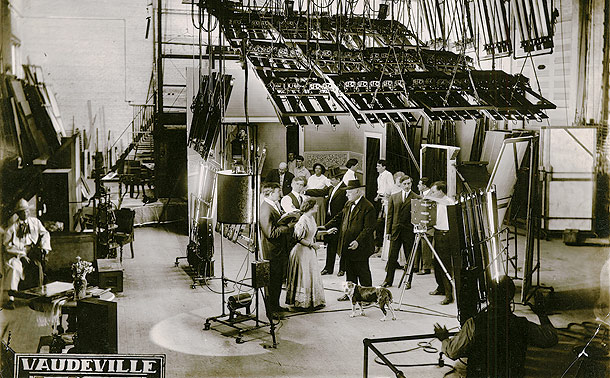
Photograph: Chicago History Museum

Bushman (above, to the left of the camera) at work inside the Essanay studio.
Throughout 1915, Chaplin made films at Essanay's California studio, moving away from straightforward slapstick into more nuanced stories. He would make about a dozen films for the Chicago-based studio, including The Tramp, which would conclude for the first time with his threadbare hero waddling along with his back to the camera, twirling his skinny cane with an ineffable melancholy-an image that would become Chaplin's signature. Thanks in part to a promotional campaign by Essanay, "Chaplinitis" swept the country. Actors donned tramp costumes and mimicked that Chaplin walk. The public snapped up Charlie spoons, lapel pins, ashtrays, and "squirt rings," as well as statuettes by the Chicago artist Cyrus LeRoy Baldridge.
In January 1916, as Chaplin's contract came up for renewal, Anderson told his partner that their comic star wanted $10,000 a week. Spoor refused to meet his demand, and Chaplin jumped ship for the Mutual Film studio-where he got his weekly salary as well as a $150,000 bonus.
With Chaplin's departure, Essanay's days were numbered. Sensing the change in fortune, Anderson sold his share of the company to Spoor. Meanwhile, the U.S. Supreme Court ruled in 1915 that Thomas Edison, Essanay, and the other studios in the Motion Picture Patents Company were violating antitrust laws, a decision that opened up the movie industry to other "independent" filmmakers. When Essanay shut down in 1918, the entire film industry was shifting toward California. By then, Bushman, Bayne, Beery, Swanson, and Turpin had already left for the coast.
A decade later, Spoor would explain his reasons for shutting down the studio. "The place was a madhouse," he said. "I tried a number of general managers with no success. I found I was running a high class school for directors and actors. I'd make stars out of them and other producers would offer them more money. I had to meet those offers or lose the stars. Had I met all the offers, I would have gone broke myself, constantly doubling salaries. So I locked up the place and took a good, long rest."
In the early 1930s, Spoor introduced "Natural Vision," an early wide-screen, 3-D film process. Spoor had spent most of his Essanay fortune-some $4 million-on the project, but it never caught on. He remained in Chicago until his death in 1953, living in an apartment at 908 West Argyle. For his pioneering contributions to the motion-picture industry, he received a special Academy Award in 1947, as did Anderson, in 1957. (Broncho Billy, who died in California in 1971, also got a star on the Hollywood Walk of Fame.)
"Movies?" Spoor said in a 1947 interview with the Chicago Sun. "No, young fellow, I don't go to the movies much anymore. You see, there are only about 30 stories in the world, and by this time I guess I know them all by heart."
* * *
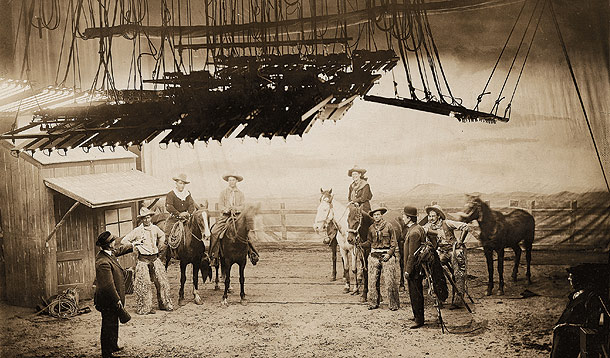
Photograph: Chicago History Museum

On the set of a Broncho Billy Western
In January 1916, after finishing Carmen, his last film for Essanay, Charlie Chaplin boarded a train for New York, a five-day trip that included a stopover in Chicago. He rode alone in an open compartment, "unrecognized," as he recalled in his autobiography, "without my comedy make-up."
But word had spread that the great movie comedian was headed east, and all along the route, crowds waited to catch a glimpse of the star. "People stood along the side of the railroad track," recalled Chaplin, "shouting and waving their hats." In the larger cities (beginning in Amarillo, Texas), they even pulled him off the train to say a few words, nearly crushing him in the process. In Chicago, an enthusiastic throng engulfed him. He escaped into a waiting limousine, which spirited him away to the Blackstone Hotel. There Chaplin received a telegram from New York's chief of police, who asked Chaplin to get off the train before arriving at Grand Central Station, where he would only be met by another mob.
To Chaplin, this was madness. He had arrived in Chicago unrecognized only a year earlier; now, 26 years old and suddenly wealthy, he had won a fame usually reserved for royalty. "I wanted to enjoy it all without reservation," Chaplin later wrote, "but I kept thinking the world had gone crazy! If a few slapstick comedies could arouse such excitement, was there not something bogus about all celebrity?" For all his success, he might just as well have been back in that cheerless Wabash Avenue flophouse. "I had always thought I would like the public's attention," reflected the solitary tramp, "and here it was-paradoxically isolating me with a depressing sense of loneliness." It was a state of mind that, in various forms, would plague him the rest of his life.




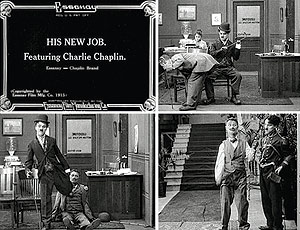 His New Job, Chapin's first Essanay movie-and his only one filmed in Chicago-also featured Gloria Swanson (seated at desk) and Ben Turpin (on the receiving end of the Tramp's antics).
His New Job, Chapin's first Essanay movie-and his only one filmed in Chicago-also featured Gloria Swanson (seated at desk) and Ben Turpin (on the receiving end of the Tramp's antics). 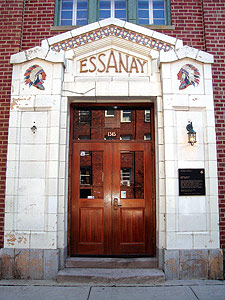 Photograph: Kim Thornton
Photograph: Kim Thornton


Comments are closed.